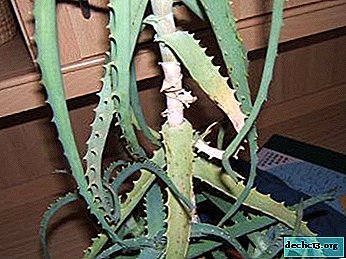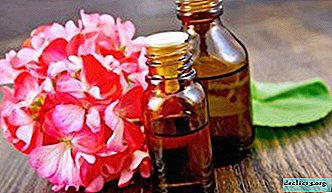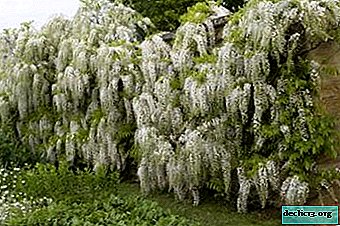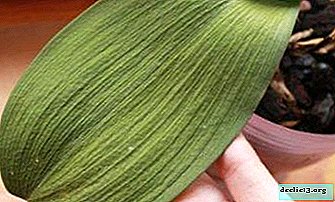Basic rules for caring for a century at home

Aloe tree is an evergreen perennial shrub. Its second popular name is agave (how the agave differs from aloe, can be found here). Almost every grower on the windowsill has this plant. It is healing. Caring for aloe vera is quite simple, but there are some features to be aware of.
Aloe arborea has a laxative, wound healing, anti-inflammatory, bactericidal, choleretic, moisturizing properties (more information about the healing properties of the agave can be found here). As an external remedy, aloe is used to treat acute and chronic purulent diseases. Use in the form of lotions, or do irrigation with juice.
Aloe Tree Care
- Lighting.
The agave is positive towards sunlight, so it is preferable to put it on the windowsill, the windows of which face south. This love of the sun is characteristic of tropical plants of South African descent. In winter, when there will be little sun, additional lighting with special lamps will be required.
- Watering.
It is necessary to carry out moderate watering 1-2 times a month. The soil should dry out between treatments. Water is suitable for room temperature, previously settled for about 10 hours. During cold weather, watering is rare.
The plant practically does not require spraying. And if this is done, then with care, so that water does not get into the leaf sockets. - Temperature.
In the summer, it should be at least 23-25, and in winter - 13-15 degrees. When frosts occur, it is very important to monitor the temperature regime, since aloe is a heat-loving plant. If the indicators decrease to zero or lower, the flower may die.
 Soil composition.
Soil composition.It is best to buy ready-made soil, suitable for succulents. It should include turf and leafy earth, sand, humus. In the process of planting, you need to add charcoal and broken brick as drainage.
- Pot.
In shape, the capacity can be absolutely any. When choosing it, you need to pay attention only to ensure that the aloe root system fits the size. The pot must have large openings at the bottom. They are needed so that excess water does not stagnate.
- What to feed?
Often, complex fertilizing includes liquid mineral fertilizers.
In no case should the fertilizer get on the stalks of aloe, as this can harm the plant or cause disease. To stimulate the growth and good condition of the flower, in the summer, such dressing should be done every two weeks. Another important condition is moist soil during top dressing.
- How to care for your roots?
Particular attention should be paid to the roots in winter. Frequent watering is not advisable during this period, as excessive humidity can lead to decay of the root system. Each grower must be vigilant and abide by all the rules and instructions for watering.
During the transplant, the roots of the plant are cleaned. Old, rotten, damaged roots are carefully removed. Thus, the care of aloe vera roots takes place. - Pruning.
The shape of mature aloe is corrected by pruning. The tops and side shoots are cut off. This allows the plant to rejuvenate. Already cut off shoots are often used as cuttings for young aloe. Do not be afraid of frequent pruning, as the plant is very hardy and tenacious.
Transfer
The roots of the tree-like aloe do not develop so slowly, so it needs to be transplanted from time to time. Young specimens are transplanted every year, aloe is older than once every 2-3 years. The capacity must be selected one and a half times more than the previous one. In autumn and winter, transplantation is strictly prohibited, since the plant is in a dormant period and will not be able to adapt to new conditions.
With root
 How to plant aloe? This must be done in the spring so that he has as little stress as possible. The composition of the new soil should not differ from the previous one. A new pot is selected a little larger.
How to plant aloe? This must be done in the spring so that he has as little stress as possible. The composition of the new soil should not differ from the previous one. A new pot is selected a little larger.
- A day before planting, it is necessary to water the plant abundantly. This is done so that it can be easily removed from the old tank without damaging the root system.
- In the process of extracting the agave, the pot is turned over and the aloe is carefully taken out, while getting rid of the old soil.
- The plant is placed in the center and covered with new soil to the previous level, then it is watered and the earth is filled as necessary.
Without root
How to transplant a plant without a root:
- For aloe transplantation in this way, you need to cut the cuttings and leave them to dry for 5-7 days until the cut completely dries out, then immediately plant them in a small container that will be filled with wet sand.It is worth noting that when trying to root, the plant may suffer, therefore this stage is not needed.
- When the agave gives roots in the sand, it is transplanted in the usual way already into permanent soil.
Preparing for the winter
During cold weather, experienced growers recommend taking aloe to the little-heated verandas, as the flower loves a cool and bright room. Since aloe belongs to succulents, the plant prefers that the temperature day and night be quite different.
- How often to water the plant in winter? In the cold season, succulents rarely need to be watered. Water should be slightly warm and only boiled.
 Aloe from the age of 3 years needs moderate and rare watering.
Aloe from the age of 3 years needs moderate and rare watering.- It is not necessary to spray the agave in winter.
- Any feeding stops.
- Transplants during colds are prohibited.
- The temperature in the room should not fall below 10 degrees.
- The plant must be protected from drafts.
- In winter, the plant will need more light, which can be given using special lamps. The lamp can be installed near the plant.
Diseases and Pests
- Why do the tips of the leaves dry??
Dry tips are a clear sign that aloe has not been transplanted for a long time. The root system took up all the free space in the pot, so the agave does not receive enough nutrients. And he begins to feed at the expense of leaves. In this case, it needs to be transplanted immediately.
- Dry rot.
Often, with this disease, aloe dies, since it is very difficult to recognize dry rot in a timely manner. The plant dries from the inside, but outwardly this does not manifest itself.
The only salvation is timely prevention. A fungicide remedy for fungi with which aloe is sprayed is suitable for the procedure. - Root rot.
The roots rot due to excessive moisture in the soil. The main reason is abundant and frequent watering. The disease is recognized by the following signs: the stem dries up, the flower does not respond to watering, and does not grow for a long time.
The disease is treated only by transplant. It is necessary to dig aloe and carefully prune the roots that are rotten. The remaining roots are sprinkled with sulfur or charcoal powder.
 After that, it is planted in a spacious container. For three weeks, it is better not to water the plant.
After that, it is planted in a spacious container. For three weeks, it is better not to water the plant. - Mealybug.
These pests suck aloe juice. They can be seen with the naked eye. Small white lumps resembling fluff or cotton wool are a sign of a mealybug. You can try to defeat the enemy with the help of garlic tincture, but if the defeat is strong, then you will have to use chemicals.
Useful video
We offer you to watch a video about the aloe tree-like plant:
Conclusion
Aloe tree - a unique resistant plant that does not require close attention. It is only necessary to observe some rules and know the features of the agave, so that home care does not bring much work.

 Soil composition.
Soil composition. Aloe from the age of 3 years needs moderate and rare watering.
Aloe from the age of 3 years needs moderate and rare watering. After that, it is planted in a spacious container. For three weeks, it is better not to water the plant.
After that, it is planted in a spacious container. For three weeks, it is better not to water the plant.















